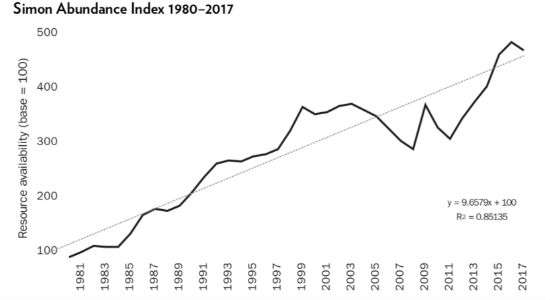Resources Are Almost 5 Times as Abundant as They Were in 1980
New Simon Abundance Index elegantly refutes primitive zero-sum intuitions with respect to population and resource availability trends.

Humanity is enjoying a world of increasingly cheap and ever more abundant mineral, argicultural, forestry and energy resources reports a brilliant new study, the Simon Abundance Index. This analysis by Marian Tupy,* editor of Human Progress at the Cato Institute, and Professor Gale Pooley from Brigham Young University – Hawaii uses data on 50 different commodities to track their price trajectories over the past 37 years from the World Bank and International Monetary Fund. They find in real price terms their basket of commodities decreased by an average of 36.3 percent between 1980 and 2017.
That's great, but their breakthrough insight is that, since 1980, global real hourly income rate per capita has grown by more than 80 percent, which means that the commodities that took 60 minutes of work to buy in 1980 now take only 21 minutes of labor to buy in 2017. As a result, the "time-price" of their basket of commodities has fallen by 64.7 percent.
Tupy and Pooley also devise a price elasticity of population (PEP) measure that finds that resource abundance increases faster than population does. In economics, they explain, elasticity is a measure of a variable's sensitivity to a change in another variable. They report:
Between 1980 and 2017, the time-price of our basket of commodities declined by 64.7 percent. Over the same time period, the world's population increased from 4.46 billion to 7.55 billion. That's a 69.3 percent increase. The PEP indicates that the time-price of our basket of commodities declined by 0.934 percent for every 1 percent increase in population.
[P]eople often assume that population growth leads to resource depletion. We found the opposite. Over the past 37 years, every additional human being born on our planet appears to have made resources proportionately more plentiful for the rest of us.
Tupy and Pooley combine their findings with regard to time-price and PEP trends to derive the Simon Abundance Index (SAI). The index is named in honor of University of Maryland economist Julian Simon. Simon famously bet Stanford University population bomber Paul Ehrlich and his colleagues that the real prices of a basket of commodities chosen by Ehrlich priced $1,000 would decline between 1980 and 1990. In October 1990, Ehrlich mailed Simon a check for $576.07, meaning that the price of the commodities had fallen by more than 50 percent.

The new SAI, explain Tupy and Pooley, represents the ratio of the change in population over the change in the time-price, times 100, with the base year at 1980 and a base value of 100. They report that "between 1980 and 2017, resource availability increased at a compounded annual growth rate of 4.32 percent. That means that the Earth was 379.6 percent more abundant in 2017 than it was in 1980."
They also report that the SAI rose to 479.6 in 2018, meaning the Earth was nearly five times more plentiful with respect to the 50 commodities they track than it it was when Ehrlich and Simon laid their famous wager. What about the future? Tupy and Pooley calculate if current trends continue that "our planet will be 83 percent more abundant in 2054 than it was in 2017."
"The world is a closed system in the way that a piano is a closed system. The instrument has only 88 notes, but those notes can be played in a nearly infinite variety of ways. The same applies to our planet," write the authors. "The Earth's atoms may be fixed, but the possible combinations of those atoms are infinite. What matters, then, is not the physical limits of our planet, but human freedom to experiment and reimagine the use of resources that we have."
The SAI devised by Tupy and Pooley elegantly refutes the primitive zero-sum intuitions peddled by the likes of Ehrlich and his acolytes that afflict so much of popular and policy discourse with respect to population and resource availability trends.
*Disclosure: Marian Tupy and I are working together on book that tracks and explains nearly 100 global population, income, commodity, and environmental trends.




Show Comments (32)